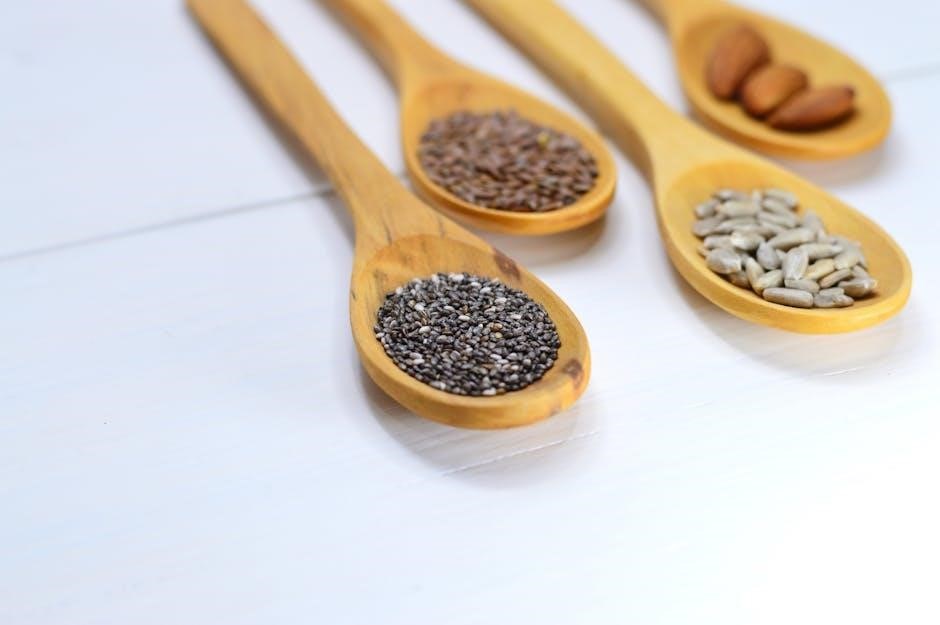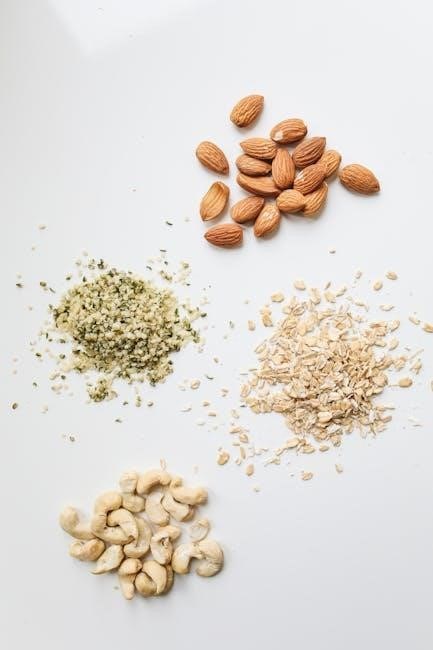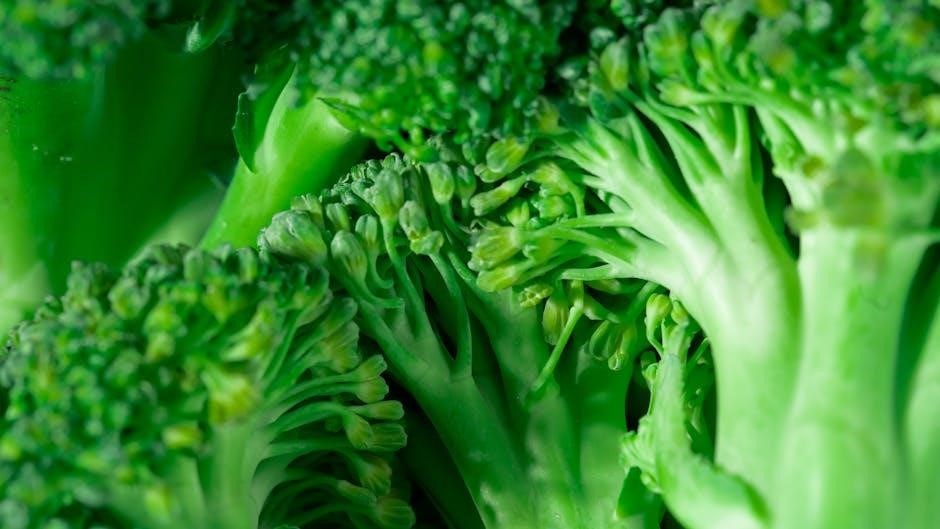
Low GI Diet Plan: A Comprehensive Guide
A Low GI Diet Plan offers a structured approach to managing blood sugar, aiding weight management, and promoting heart health through strategic food choices. It provides practical tips for implementing the diet effectively while maintaining a balanced nutrient intake.
A low GI diet focuses on selecting foods that slowly release glucose, helping maintain stable blood sugar levels. This approach is particularly beneficial for managing conditions like diabetes, supporting weight management, and enhancing heart health. By choosing low GI foods, individuals can enjoy sustained energy levels and improved overall health. Consulting a dietitian can provide personalized guidance for effective implementation.

Understanding the Glycemic Index (GI)
The Glycemic Index (GI) measures how quickly foods raise blood sugar levels. It helps identify carbohydrate-rich foods that stabilize blood sugar, aiding in better dietary choices for health management.
What is the Glycemic Index?
The Glycemic Index (GI) is a scale measuring how foods affect blood sugar levels. It ranks carbohydrates on a scale from 0 to 100, with pure glucose at 100. Foods with a high GI, like white bread, cause rapid blood sugar spikes, while low GI foods, such as whole grains, result in gradual increases. The GI helps guide dietary choices for blood sugar management and energy balance, particularly for those with diabetes or those seeking steady energy levels. Understanding the GI involves knowing it’s measured through controlled studies where blood sugar responses to specific foods are monitored. While it’s a valuable tool, it’s often used alongside other nutritional considerations for a comprehensive approach to healthy eating.
High GI vs. Low GI Foods
High GI foods, like white bread and sugary snacks, cause rapid blood sugar spikes, while low GI foods, such as whole grains and vegetables, lead to gradual increases. High GI foods are quickly digested, triggering insulin surges, whereas low GI foods release glucose slowly, promoting stable energy levels. Understanding this distinction helps in making informed dietary choices for better blood sugar control and overall health.
Why Low GI Foods are Better for Blood Sugar Control
Low GI foods are better for blood sugar control because they digest slowly, preventing rapid spikes in blood sugar levels. This gradual release of glucose helps maintain stable energy and reduces insulin surges. By minimizing sharp fluctuations, low GI foods support better metabolic health, making them ideal for managing diabetes and preventing conditions like insulin resistance and metabolic syndrome.
Benefits of a Low GI Diet
A low GI diet promotes stable blood sugar levels, supports weight management, and enhances heart health by reducing inflammation and improving cholesterol levels.
Weight Management
A low GI diet aids in weight management by stabilizing blood sugar levels, preventing sharp spikes that trigger overeating. It promotes satiety, reducing overall calorie intake, and supports a healthier metabolism, making it easier to maintain a balanced weight over time.
Improved Blood Sugar Levels
A low GI diet helps stabilize blood sugar levels by slowing carbohydrate digestion, preventing sudden spikes. This reduces insulin surges, benefiting those with diabetes or prediabetes. Consistently choosing low GI foods minimizes glucose fluctuations, supporting long-term blood sugar control and overall metabolic health, as recommended by health organizations like Diabetes Canada;
Enhanced Heart Health
A low GI diet supports heart health by reducing inflammation and improving lipid profiles. It helps lower cholesterol and triglycerides, minimizing the risk of cardiovascular diseases. Stable blood sugar levels also decrease the strain on blood vessels, promoting healthier blood pressure. This approach aligns with recommendations from health organizations, emphasizing the role of diet in preventing heart-related conditions.
Increased Satiety and Reduced Hunger
Low GI foods digest slowly, keeping blood sugar levels steady and promoting longer-lasting fullness. This reduces hunger pangs and cravings, making it easier to manage calorie intake. Incorporating high-fiber, protein-rich, and healthy fats into meals enhances satiety, helping maintain energy levels and supporting weight management goals effectively.

Foods to Include in a Low GI Diet
A low GI diet emphasizes whole, unprocessed foods like vegetables, whole grains, lean proteins, and healthy fats. These foods are rich in fiber and nutrients, promoting gradual digestion and sustained energy levels.
Best Low GI Foods for Breakfast
Start your day with low GI options like oatmeal, whole-grain cereals, or eggs. Pair with nuts, seeds, or avocado for added fiber and protein. Greek yogurt with berries or a smoothie made with spinach, almond milk, and chia seeds are also excellent choices. These foods provide sustained energy and help regulate blood sugar levels throughout the morning.
Low GI Snacks for Midday Cravings
Opt for low GI snacks like raw almonds, carrot sticks with hummus, or a small apple with peanut butter. Greek yogurt with a handful of berries or a hard-boiled egg also makes a satisfying choice. These snacks provide steady energy, curb hunger, and support blood sugar balance without causing a spike.
Healthy Low GI Dinner Options
Choose whole grains like quinoa or brown rice paired with grilled chicken or fish. Steamed vegetables such as broccoli, spinach, or asparagus add fiber and nutrients. Incorporate legumes like lentils or chickpeas for protein and slow-digesting carbs. A balanced dinner with these elements ensures sustained energy and supports blood sugar stability while keeping you satisfied until the next meal.
Foods to Avoid on a Low GI Diet

Limit high GI foods like white bread, sugary snacks, and refined carbohydrates. Avoid processed foods with hidden sugars and opt for whole, unprocessed options to stabilize blood sugar.
High GI Foods That Spike Blood Sugar
High GI foods, such as white bread, white rice, sugary snacks, and refined carbohydrates, cause rapid blood sugar spikes. These foods are quickly digested, leading to sharp increases in glucose levels. Limiting them is crucial for maintaining stable blood sugar and overall health. Opt for whole, unprocessed alternatives to mitigate these effects.
Processed Foods to Limit
Processed foods, such as sugary snacks, frozen meals, and sugary drinks, often contain hidden sugars and refined carbs. These foods are high in GI, causing rapid blood sugar spikes and insulin surges. Limiting them helps maintain stable blood sugar levels and supports overall health. Opt for whole, unprocessed foods to reduce exposure to these harmful ingredients.
Sample Low GI Meal Plan
A sample Low GI meal plan offers balanced breakfast, lunch, and dinner options, emphasizing whole, nutrient-dense foods to maintain stable blood sugar levels and support overall health.
Breakfast Ideas

Start your day with balanced Low GI breakfasts like oatmeal with berries, scrambled eggs with spinach, or Greek yogurt with chia seeds. Whole-grain toast with avocado or smoothies made with spinach, almond milk, and protein powder are also great options. These meals provide sustained energy and help maintain stable blood sugar levels throughout the morning.
Lunch Suggestions
Focus on whole grains, lean proteins, and vegetables for a balanced Low GI lunch. Grilled chicken with quinoa, steamed broccoli, and a side salad are excellent choices. Lentil soup or whole-grain wraps with turkey and avocado also work well. These options help regulate blood sugar and provide sustained energy, keeping you satisfied until dinner.

Dinner Recipes
Baked salmon with asparagus and brown rice is a hearty Low GI dinner option. Stuffed bell peppers with lean ground turkey, quinoa, and spinach also work well. For vegetarian options, try roasted vegetable stir-fries with tofu and wild rice. These recipes balance protein, fiber, and healthy fats, ensuring sustained energy and stable blood sugar levels.
Incorporate a variety of colorful vegetables like zucchini, carrots, and Brussels sprouts for added nutrients. Pairing grilled chicken with sweet potatoes and green beans provides a delicious, well-rounded meal. Don’t forget to season with herbs and spices for flavor without adding sugars or unhealthy fats. Portion control and balanced macronutrients are key to maintaining a Low GI diet.
Snack Options
Healthy Low GI snacks include nuts like almonds and walnuts, fresh fruits such as apples and berries, and vegetable sticks with hummus. Greek yogurt with a sprinkle of chia seeds is another excellent choice. Hard-boiled eggs and whole grain crackers with avocado or peanut butter also make great snacks, providing sustained energy and satisfying hunger.
These snacks are rich in fiber, protein, and healthy fats, helping to maintain stable blood sugar levels and curb cravings throughout the day.

Tips for Implementing a Low GI Diet
Start by planning meals, reading food labels, and controlling portion sizes. Gradually replace high GI foods with low GI alternatives and seek guidance from a dietitian.
Stocking Your Pantry
Focus on whole, unprocessed foods like whole grains, non-starchy vegetables, lean proteins, and healthy fats. Avoid high GI foods and processed items. Incorporate legumes, nuts, and seeds for fiber and sustained energy. Keep low GI snacks handy, such as fruits and yogurt, to manage cravings. Regularly check expiration dates and restock essentials to maintain a balanced and nutritious low GI diet.
Tracking Your GI Intake
Use a food diary or app to monitor the glycemic index of meals. Note portion sizes and blood sugar responses; Set reminders for regular tracking to maintain consistency. Collaborate with a dietitian to tailor your approach. This helps identify patterns and optimize food choices for better blood sugar management and overall health outcomes.
Maintaining a Balanced Diet
A low GI diet emphasizes variety and nutrient-rich foods. Incorporate lean proteins, healthy fats, and fiber-rich vegetables alongside low GI carbohydrates. Portion control and mindful eating are key to sustaining balance. Regularly consult with a dietitian to ensure diverse nutrient intake and adapt the plan to meet individual needs for long-term health benefits.
Common Mistakes to Avoid
- Overconsumption of hidden sugars in low GI foods.
- Ignoring portion sizes, leading to excessive calorie intake.
- Neglecting nutrient diversity, risking deficiencies.
Avoiding these mistakes ensures a balanced and effective low GI diet.
Overconsumption of Hidden Sugars
Even low GI foods can contain hidden sugars, leading to blood sugar spikes. Avoid processed foods and flavored products, as they often harbor added sugars. Opt for whole, unprocessed foods like vegetables, lean proteins, and whole grains to minimize sugar intake. Always check food labels for added sugars and limit them to maintain blood sugar balance and overall health benefits of the low GI diet.
Ignoring Portion Sizes

Even low GI foods can lead to blood sugar spikes and weight gain if consumed in large portions. Overeating, regardless of GI, disrupts blood sugar balance and hinders weight management. Use smaller plates, measure servings, and practice mindful eating to avoid overconsumption. Portion control is essential for maximizing the benefits of a low GI diet and maintaining overall health.
Neglecting Nutrient Diversity
A low GI diet must include a variety of foods to ensure adequate nutrient intake. Relying solely on low GI options without considering vitamins, minerals, and fiber can lead to deficiencies. Incorporate diverse whole foods like vegetables, lean proteins, and healthy fats to maintain a balanced diet and optimize overall health benefits.

Consulting a Professional
Working with a Registered Dietitian or healthcare provider ensures a personalized low GI diet plan tailored to your health goals and needs, optimizing blood sugar control and overall well-being.
Role of a Dietitian in Planning
A Registered Dietitian plays a crucial role in creating a personalized low GI diet plan, offering tailored strategies to manage blood sugar and weight. They provide expert guidance on food choices, portion control, and meal timing, ensuring the diet aligns with individual health goals. Their expertise helps individuals navigate the complexities of glycemic control effectively.

Importance of Personalized Advice
Personalized advice ensures a low GI diet plan is tailored to individual needs, health status, and lifestyle. It helps maximize the diet’s effectiveness, address specific health goals, and maintain long-term sustainability. Customized recommendations enable better adherence and improved outcomes, making the journey to better blood sugar control and overall health more achievable and sustainable.